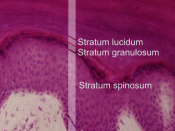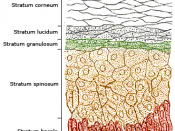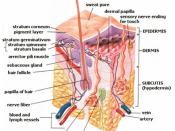1.Summarize the formation of friction ridge skin and how it relates to the permanence of fingerprints.
The skin over most of our bodies is fairly smooth. 'Friction Ridges', however, are found on the digits, palms and soles. They are called 'friction' ridges because of their biological function that helps us grasp and hold onto objects. Sometimes compared to fine lines found in corduroy, unlike corduroy, ridges vary in length and width, branch off, end suddenly and, for the most part, flow with each other to form distinct patterns .The ridge path can sometimes be very fragmented . There are about 2,700 ridge "units" per square inch of friction skin. Each ridge "unit" corresponds to one primary epidermal ridge (glandular fold) formed directly under each pore opening. Pore openings exist along the surface of the friction ridges. They are pretty evenly spaced. This is due to the fact that one pore opening along with one sweat gland exists for each ridge "unit".
Friction ridges are in their definitive form on the fetus before birth. Once this blueprint has been established, in the stratum basale (generating layer) of the epidermis on the fetus prior to birth, it does not change except from injury, disease or decomposition occurring after death. Injury sustained by generating layer (Stratum basale) may affect the skin's ability to regenerate and scar tissue forms.
Location and size of pore ducts and pore openings along the surface of friction ridge skin are also definitive form before birth and will not change. Cross-section of Friction Skin
Thick skin (which includes friction skin) contains two principle layers:
The Epidermis (E) is stratified (layered), squamous (flat) epithelial tissue 5 layers thick and... The Dermis is much thicker than the epidermis and consists of two layers - the Papillary layer (DPL) an area...


